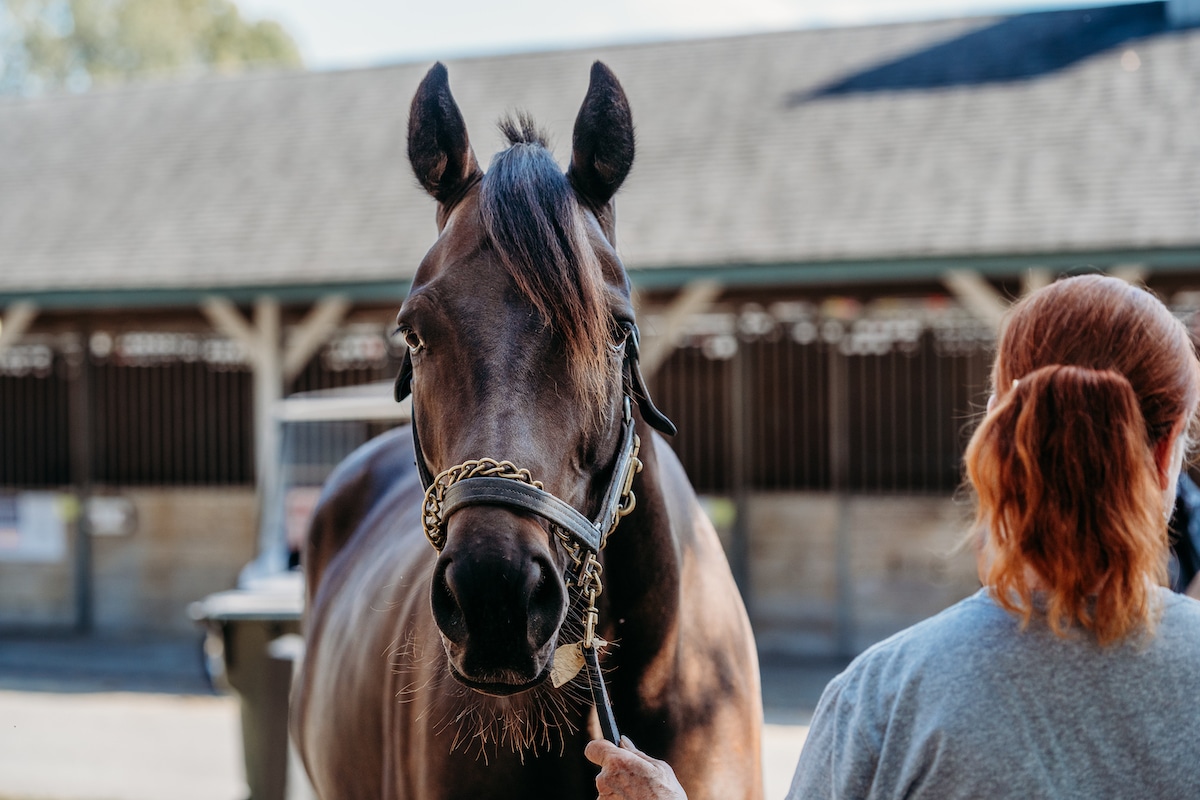
As an old saying goes, “If he was a good stallion, he’ll be an outstanding gelding.” Photo by Captivation Photograhy
Stallions can present a variety of management and behavioral challenges. They can be unpredictable or aggressive and often cannot be housed with or in proximity to other horses, especially mares. Thus, most colts not intended for breeding purposes are castrated (aka gelded) as weanlings, yearlings or 2-year-olds.
Racehorses, however, often remain intact longer than show or pleasure prospects, because bloodlines or racing talent might make them worthy for the breeding shed after their racing careers are over. Intact male Thoroughbreds on the racetrack can also be easier to manage than other colts and stallions — they get handled and exercised daily, and their housing and environment are closely controlled. Many colts of racing age — especially 2- and 3-year-olds — haven’t matured enough to show strong effects of testosterone, so aggressive behaviors are less of a problem.
Some racehorses are left intact even if they aren’t intended as breeding prospects. They might have naturally agreeable demeanors, or perhaps their owners don’t want to make any physical changes to horses that are racing well. When these horses move on to new careers, however, most owners will enjoy them more once they are gelded.
How Vets Castrate Horses
Castration surgery is usually a straightforward, low-risk procedure. Complication rates can increase as horses age, but research reveals conflicting data on this. Sometimes, a horse was not castrated because he is a unilateral or bilateral cryptorchid — meaning one or both testicles did not descend out of the inguinal ring. This type of surgery is more complex and involves a longer duration of anesthesia. Horses on the track with one undescended testicle are called “ridglings.” (It is crucial to note that all cryptorchids are still colts or stallions and should be handled accordingly because they tend to have all the behaviors associated with being intact.)
For any castration surgery the veterinarian administers perioperative (before, during and after surgery) antibiotics and non-steroidal anti-inflammatory drugs (NSAIDs) to the horse. It is also imperative that the horse is up to date on tetanus vaccination, as most castration incisions are left open and allowed to heal by second intention.
For routine castrations vets use short-acting general anesthesia, though they can also perform the procedure with the horse standing. Under anesthesia, the horse is placed in lateral recumbency (on his side) or dorsal recumbency (on his back). The former is most common for castrations where both testicles are readily identifiable; the latter is more common for cryptorchid surgeries.
In lateral recumbency the vet pulls the top leg up and forward to access the testicles. After preparing the incision site with a surgical scrub, the surgeon makes an incision with a scalpel over the length of the testicle — typically the smaller one first — parallel to the midline of the horse’s belly. If using the common “open” surgical technique, the incision extends down through the tissue surrounding the testicle, allowing the testicle to pop out of the incision, along with the epididymis (the duct through which sperm pass).
Each testicle is suspended within the scrotum by a spermatic cord, which the vet clamps for several minutes using a crushing tool called an emasculator. The crushing action prevents bleeding. In most full-sized horses the vet also places one or more ligating sutures around the cord to help minimize blood loss. Then he or she repeats the process for the second testicle. Before allowing the horse to recover from anesthesia, the vet checks the cords for excess bleeding.
Some vets use slightly different surgical techniques, such as closed or semiclosed, or use a Henderson tool, which “seals” each spermatic cord by twisting it around itself (see page 100; the tool attaches to a drill). The technique your vet chooses depends on his or her experience and comfort level with each technique.
An experienced equine surgeon should perform cryptorchid surgeries, because undescended testicles can be located anywhere from just inside the inguinal ring (close to the scrotum, where they normally descend) all the way to the abdominal cavity. These testicles are usually small and can have an abnormal appearance. With the horse in dorsal recumbency, the surgeon makes an incision over the external inguinal ring and locates the testicle. If the horse has only one undescended testicle, it should be removed before the normal testicle.
Post-castration, geldings are given NSAIDs for several days. After the first 24 hours of stall rest, new geldings can usually be turned out in a private paddock. They should have at least 20 minutes of forced exercise daily for 10-14 days to prevent excessive swelling and aid any drainage.
Postoperative instructions vary for adult horses versus younger ones. “I really emphasize the exercise component and cold-hosing, if possible, for the mature horses, as they tend to get more swelling and edema,” says Jenna Young, DVM, Dipl. ACVS, associate professor of large animal surgery at the University of Minnesota, in St. Paul. “I recommend at least twice-daily longeing at a brisk trot for 20-30 minutes and turnout 24 hours after surgery for the following two weeks. I also prescribe NSAIDs to be used a bit longer — five to seven days — to help control the swelling and inflammation. The NSAIDs also help the horses feel better and more likely to exercise themselves in turnout.”
Castration Surgery Complications
Most horses recover uneventfully from castration but, as with any surgery, complications can occur. In a 2013 study Kilcoyne et al. found the overall complication rate of routine castrations to be about 10%. The most common complications are hemorrhage, swelling and infection. Very rarely, herniation of the small intestine through the inguinal canal can occur. Complications of general anesthesia, such as facial or forelimb nerve paralysis, are uncommon but possible. Report any excessive bleeding, swelling that doesn’t respond to exercise, fever or purulent (containing pus) drainage to your vet right away.
Usually, surgeons address excessive hemorrhage immediately post-surgery. If abnormal bleeding persists after the horse stands following anesthesia, the vet will take steps to identify the source of the bleeding and/or pack the incision site and monitor it closely. Swelling around the surgical sites usually peaks around three to five days post-castration and can be mitigated by cold-hosing the site and regular exercise. Sometimes a seroma, or fluid-filled swelling, can form; in these cases the vet must reopen the surgical sites to allow for drainage. Infections can develop days after the procedure and often cause fever and discomfort. Vets can treat these with broad-spectrum antibiotics, exercise and promoting drainage. Occasionally, a condition called scirrhous cord develops, where the incisions heal normally but the spermatic cord stump remains chronically infected. When this occurs the practitioner must remove the infected tissue for complete resolution.
Some complications are more common in mature horses. “The most common complication a few days out in this population is the swelling and edema, which can then lead to more complications, such as seroma or infection, if not recognized and dealt with properly,” says Young.
Behavioral Changes
While vets and trainers often refer to castrations as “brain surgery” — a tongue-in-cheek reference to a horse being more manageable as a gelding — the change is not instantaneous. Testosterone and estrogen levels begin to decrease in the bloodstream as quickly as six hours post-castration but take weeks to dissipate completely.
Innate and learned equine behaviors can take some time to go away. If a colt or stallion had hormone-related behavior issues prior to castration, it can take weeks, months or years for them to resolve. In older horses, especially those that have been used for breeding, some stallionlike behaviors sometimes persist indefinitely, notes Young.
Most new geldings’ stallionlike behavior improves rapidly, though, and these horses become much lower-maintenance in a barn setting. It is important to remember that immediately post-surgery, new geldings retain a bit of semen in the vas deferens, so avoid exposing them to mares for about 30 days.
Patient and proper training can enhance positive behavior change in new geldings. With off-track Thoroughbreds, this process can be seamless because many colts and stallions were well-handled with training that insisted on proper manners prior to castration. As an old saying goes, “If he was a good stallion, he’ll be an outstanding gelding.”
Jennifer Selvig, DVM, is an owner at Cleary Lake Veterinary Hospital, in Prior Lake, Minnesota. She also owns and operates Stargazer Farm LLC, has several OTTBs and is on the national board of CANTER USA.

